Chervil Plant
- April 1, 2024
- 0 comment
Chervil Plant (Anthriscus cerefolium), is a delicate annual herb related to parsley which is commonly used to season mild-flavoured dishes. This feathery-leaved plant thrives in cool environments and can often be found gracing kitchen gardens and windowsills. Its leaves are light green, with a slight resemblance to those of carrot plants, lending a soft texture to the garden palette.
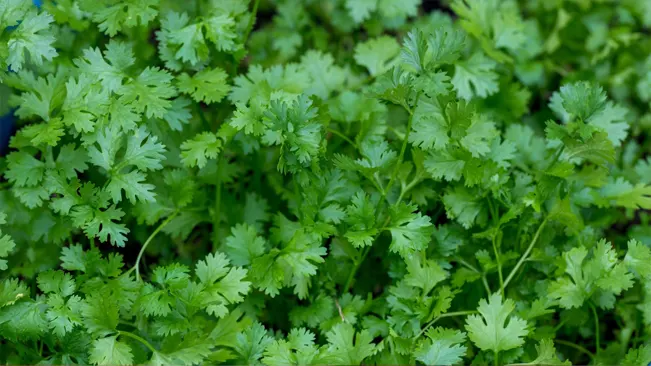
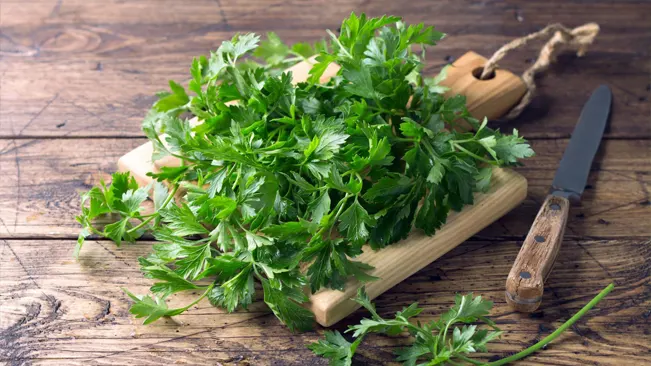
Chervil Plant, with its refined taste reminiscent of tarragon and fennel and gentle anise undertones, is a cherished herb in French culinary traditions, often featured in the fines herbes ensemble. In the realm of gastronomy, its mild yet distinctive flavor complements a wide array of dishes, from soups to sauces. Moreover, chervil enhances herb gardens with its charming white blossoms, which not only add visual allure but also invite a host of pollinators, enriching the garden’s biodiversity.
Characteristics of Chervil Plant
| Characteristics | Description |
| Scientific Name | Anthriscus cerefolium |
| Common Names | Chervil, garden chervil, French parsley |
| Family | Apiaceae Family |
| Native Region | Native to Caucasus region and spread into Europe |
| Plant Type | Chervil is an aromatic annual herb with a quick growth cycle. |
| Size | Grows up to 12 to 24 inches in height. |
| Leaves | Light green, lacy, and delicate, resembling carrot tops. |
| Flowers | Small, white flowers forming umbrella-shaped clusters. |
| Propagation | ypically propagated by seed and can self-sow in suitable conditions. |
| Drought Tolerance | Prefers moisture and is not particularly drought-tolerant. |
| Cultural Uses | Used as a culinary herb, particularly in French cuisine. |
| Ecological Role | Attracts beneficial insects, including pollinators like bees. |
| Notable Species | Primarily cultivated as a single species. |
| Hardiness Zones | Best grown in USDA zones 3 through 7 |
| Growth Rate | Fast-growing, reaching maturity in 6 to 8 weeks |
| Lifespan | Completes its life cycle within one growing season. |
Botanical Beauty of Chervil Plant
Chervil’s botanical beauty lies in its delicate, lace-like leaves and tiny, cloud-like clusters of white flowers that present a soft contrast against the darker greens of a herb garden. This humble herb may not boast bold colors, but its intricate foliage patterns are a delight for those who appreciate subtle garden textures. In the gentle sway of spring breezes, chervil adds a dimension of fine detail that complements more substantial plants with its understated elegance.
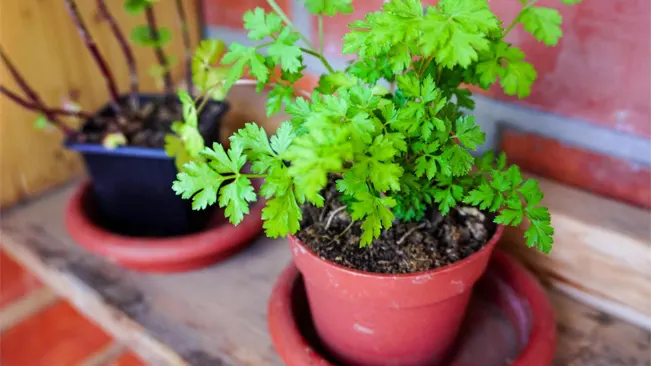
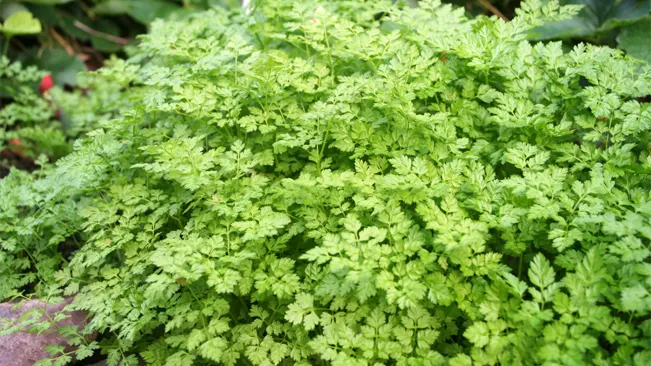
Woodland Elegance
In a woodland setting, chervil’s subtle form meshes seamlessly with the understory, its ferny leaves capturing dappled sunlight. The plant’s small white blossoms stand out like flecks of starlight against the rich tapestry of a forest floor.
Ecological Importance
Ecologically, chervil is a friendly neighbor in the plant community, offering its flowers as a nectar source for early-season pollinators when few other food sources are available. It also acts as a nurse plant, providing a beneficial microclimate for the germination of more delicate woodland flora.
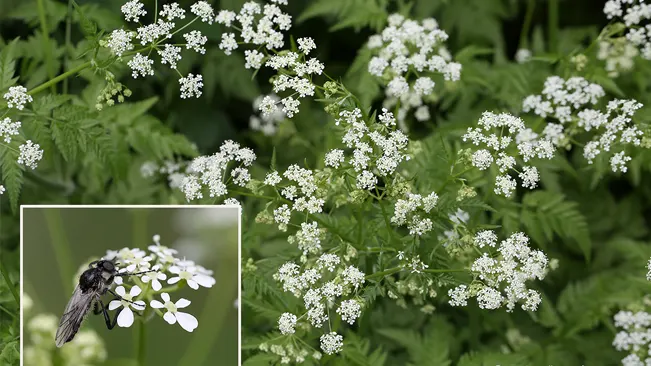
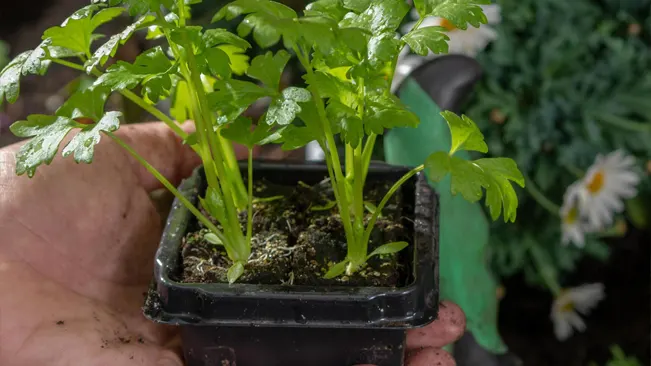
Cultivation and Conservation
The cultivation of chervil is a nod to the tradition of kitchen gardens, where this herb is grown for its culinary virtues and ease of care, thriving in cool temperatures and part shade. Its ability to self-seed makes chervil a low-maintenance choice for conservation-minded gardeners, promoting biodiversity within the garden ecosystem.
Fragrance

Chervil, a delicate culinary herb, is renowned for its subtle and refined fragrance. It emits a mild aroma that is a blend of anise and parsley, which is soothing and not overpowering. This fragrance becomes more pronounced when the leaves are freshly crushed, releasing their essential oils.
In the tranquil ambiance of a garden, chervil’s fragrance plays a pivotal role in crafting a delightful sensory journey. As dawn breaks and dew gently kisses the foliage, the herb’s scent becomes more vivid and enchanting, intertwining with the fresh morning air. Many gardeners cherish chervil’s presence, cultivating it in herb gardens and window boxes not only for its culinary uses but also to immerse themselves in its pleasing, natural perfume, which adds a layer of aromatic bliss to their gardening experience.
The fragrance of chervil is not just limited to gardens; it also enhances the aroma of various dishes. When added to recipes, it imparts a light, anise-like scent that complements other ingredients. This characteristic makes it a favorite in French cuisine, particularly in spring dishes.
Soil Stabilization
Chervil plays a unique role in soil stabilization, particularly in garden ecosystems. Its root system helps in binding the soil, thereby reducing erosion. This quality is especially beneficial in areas with loose or sandy soil.
When used in crop rotation or as a part of a polyculture garden, chervil contributes to maintaining soil health. Its presence can help in breaking up compacted soil, allowing better water infiltration and air circulation. This aids in the overall fertility and structure of the garden soil.
Beyond its culinary uses, chervil is also appreciated for its ability to attract beneficial insects. These insects aid in pollination and also help in controlling pests, creating a more balanced and healthy garden ecosystem. This indirectly contributes to soil health, as a balanced ecosystem promotes healthier plant growth and soil stability.
Common Uses

Chervil is most commonly used as a culinary herb, particularly in French cuisine. It is a key ingredient in the classic French herb mixture known as “fines herbes,” along with parsley, tarragon, and chives. Its delicate flavor is best when added at the end of cooking to preserve its aroma.
Apart from cooking, chervil is also used in traditional medicine. Its leaves are believed to have mild diuretic properties and have been used in herbal teas to aid digestion. Additionally, chervil has been utilized in soothing eye compresses and for relieving mild skin irritations.
In the culinary uses, chervil finds its way into a variety of dishes. It’s particularly popular in salads, soups, and egg dishes, where its subtle flavor can be appreciated without overpowering other ingredients. Chervil is also used as a garnish, adding both flavor and visual appeal to dishes.
Benefits
Chervil offers a range of health benefits due to its nutritional content. It is rich in vitamins, particularly vitamin C, and contains minerals like iron and magnesium. This composition makes it beneficial for boosting immunity and improving overall health.
The herb is also known for its antioxidant properties. These antioxidants help in neutralizing harmful free radicals in the body, thus potentially reducing the risk of chronic diseases. Chervil’s anti-inflammatory properties also contribute to its health benefits.
Additionally, chervil has been traditionally used for its medicinal properties. It is believed to aid in digestion and help in regulating blood pressure. The mild diuretic effect of chervil can also aid in detoxification and improving kidney function, adding to its range of health benefits.
Different Species
Anthriscus cerefolium
(Garden Chervil)
This type, celebrated for its delicate and refined flavor, is the most recognized and widely used in culinary contexts. It is characterized by its light green, intricately lacy leaves, exuding a subtle elegance. Highly esteemed in French cuisine, it’s a quintessential ingredient in many classic dishes, where its unique taste and aesthetic appeal are cherished by chefs and gourmets alike.
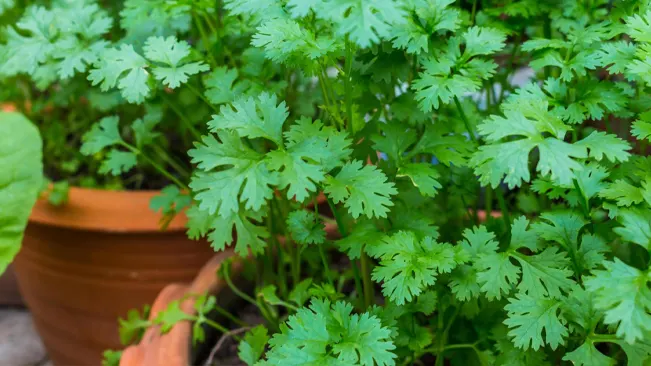
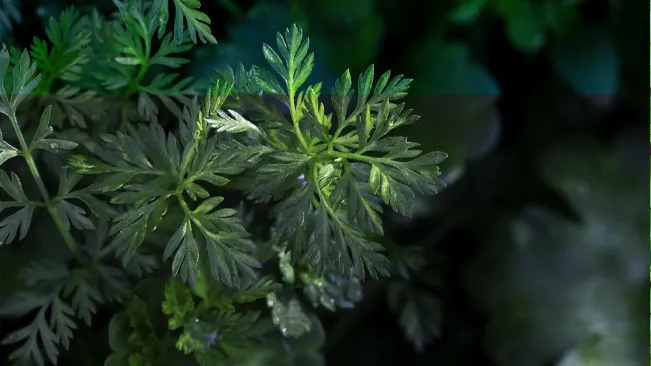
Anthriscus sylvestris
(Wild Chervil)
A wild relative of garden chervil, it’s often found in woodlands and fields. Wild chervil is taller and has larger, more robust leaves than garden chervil. While it’s not typically used in cooking due to its stronger flavor, it’s an important species in wild ecosystems.
Anthriscus caucalis
(Bur Chervil)
This species is characterized by its burr-like fruit, and it’s often found in disturbed soils. While it shares a visual resemblance with garden chervil, its culinary use is not as common due to its different flavor profile.
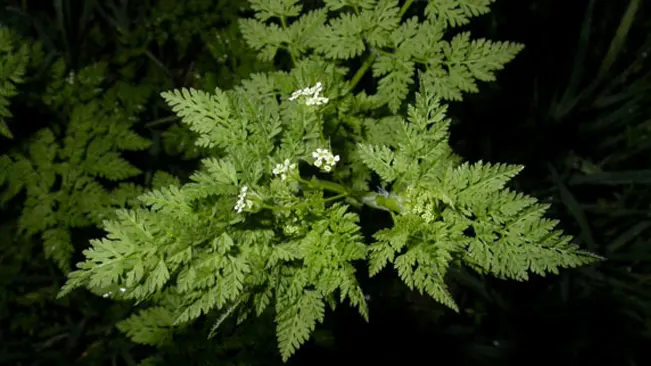
Frequently Asked Questions (FAQs)
- What is chervil plant and how is it used in cooking?
- Chervil plant is a delicate culinary herb known for its subtle flavor, commonly used in French cuisine, especially in soups, salads, and egg dishes.
- Chervil plant is a delicate culinary herb known for its subtle flavor, commonly used in French cuisine, especially in soups, salads, and egg dishes.
- Can chervil plant be grown indoors?
- Yes, chervil plant can be grown indoors, preferably in pots with well-drained soil and in areas that receive moderate sunlight.
- Yes, chervil plant can be grown indoors, preferably in pots with well-drained soil and in areas that receive moderate sunlight.
- How does chervil plant differ from parsley?
- While visually similar, chervil plant has a more delicate flavor with hints of anise, unlike the stronger, more robust taste of parsley.
- While visually similar, chervil plant has a more delicate flavor with hints of anise, unlike the stronger, more robust taste of parsley.
- What are the health benefits of chervil plant?
- Chervil plant is rich in vitamins and minerals, and is believed to have diuretic properties as well as potential benefits for digestion and skin health.
- Chervil plant is rich in vitamins and minerals, and is believed to have diuretic properties as well as potential benefits for digestion and skin health.
- How should chervil plant be stored for maximum freshness?
- Chervil plant should be stored in a refrigerator, wrapped in a damp paper towel and placed in a plastic bag, to maintain its freshness.
- Chervil plant should be stored in a refrigerator, wrapped in a damp paper towel and placed in a plastic bag, to maintain its freshness.
- Can chervil plant be used as a substitute for other herbs?
- Yes, chervil plant can sometimes substitute for parsley or tarragon, though it has a milder flavor.
- Yes, chervil plant can sometimes substitute for parsley or tarragon, though it has a milder flavor.
- When is the best time to harvest chervil plant?
- Chervil plant is best harvested before it flowers, when the leaves are young and tender, usually in late spring or early summer.
- Chervil plant is best harvested before it flowers, when the leaves are young and tender, usually in late spring or early summer.
- Is chervil plant easy to grow?
- Yes, chervil plant is relatively easy to grow in cooler climates and prefers well-drained soil and partial shade.
- Yes, chervil plant is relatively easy to grow in cooler climates and prefers well-drained soil and partial shade.
- What dishes are best complemented by chervil plant?
- Chervil plant is great in light, spring dishes like omelettes, creamy sauces, and herbed butters, where its delicate flavor can shine.
- Chervil plant is great in light, spring dishes like omelettes, creamy sauces, and herbed butters, where its delicate flavor can shine.
- Can chervil plant be dried like other herbs?
- While it can be dried, chervil plant is best used fresh as drying diminishes its flavor significantly. If needed, freezing is a better option for preserving its aroma.


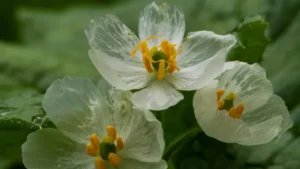


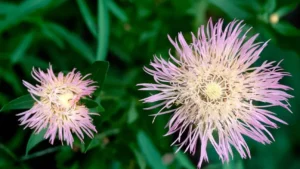



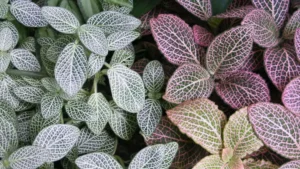
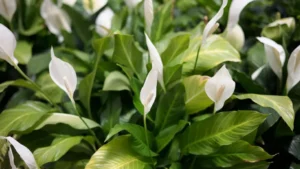
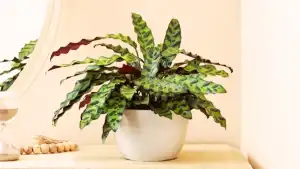
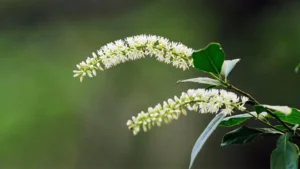

Leave your comment